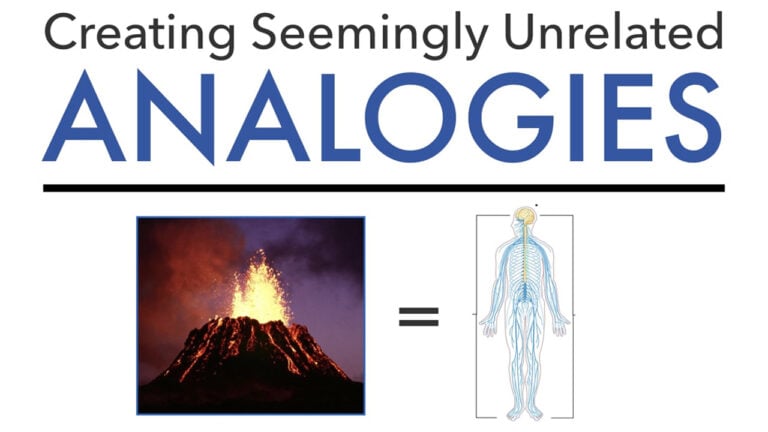Gosh, I loved it when my students spotted an unexpected relationship. Some strange connection that surprised even me. “Mr. Byrd! This reminds me of…”
It’s fun, of course. It’s creative. But, more importantly, it demonstrates a deep understanding of both sides of the relationship. Students aren’t just memorizing facts. They’re applying their knowledge. They are analyzing by comparing and finding patterns. Push them a bit, and you could take them all the way to synthesize.
Let’s Lower The Floor
Now, some students do this naturally. But we can teach other students to also spot those unexpected relationships? Well, we’re professional teachers, right? You bet we can teach something!
We need to build out the scaffolding. Student Y is already way up there on Blooms. How do we find some footholds so Student X can join them? We’re planning for a high ceiling, but building out a low floor.
I worked on a sequence to help students find unpredictable parallels across any content area. The whole thing is available in video form if you’re a Byrdseed.TV subscriber.
1. Pick The Content
First, we need to pick two pieces of content. I chose the human body and a volcano. You can choose whatever you’d like. The less obviously connected, the better. The sense of excitement in finding connections is greater when the ideas seem impossibly distant.

You should probably pick this content for students at first. That will lower the floor. You can always release responsibility as students show that they’re ready. You can’t always win back overwhelmed kids.
2a and 2b. Brainstorm Terms
Next, we brainstorm the most important terms for each of the two ideas. This is language of the discipline.
Treat the two content areas as two separate tasks (2a and 2b!). Don’t start connecting yet. Just get lots of ideas down. What are the essential terms/words/ideas/details of the human body? What about volcanoes? The bigger the list, the better.
3. Connect One Term
Only now do we look for a connection. Pick one term from Content #1 and then browse for a related idea in Content #2. In the video lesson, I start with “conduits” in the volcano section and then look for a parallel with the human body. Ah, veins! With this scaffolding, students will find connections much faster.
4. Now Keep Connecting
Then, once students start to get it, let them build out more connections using other terms. Go in both directions, (human to volcano and volcano to human). This will trigger more ideas than just thinking in one direction.
Encourage students to try lots of ideas. Some will be bad. Some will be horrible. But some will be fantastic!
5. Then They Make A…
Now that we have our high level of thinking set up, we can think about the product.
I decided to have students write a tiny story in which the two pieces of content meet each other and discuss their similarities. Now, yes, this could become a comic, a skit, a larger narrative, or just a paragraph-long story. The product’s job is to give students a way to show off their thinking.
Sure, the product can be cute and fun and fancy. But don’t let that stuff get in the way of the product’s core job. A paragraph written in pencil can show off thinking just as well (and often better) than a fancy 3D-printed doodad with sprinkles on top.
I’d love to see what students write about when a volcano and a human meet. Perhaps they’ll start by noting, “Hey! We both have tubes that run under our surface and transport important material! Mine are called veins, but yours are conduits? Weird!”

